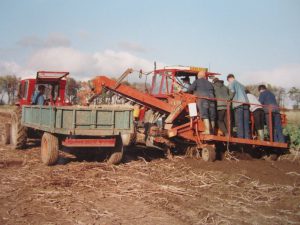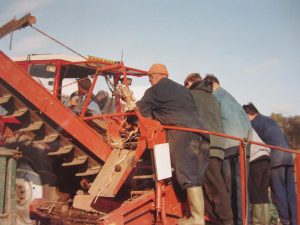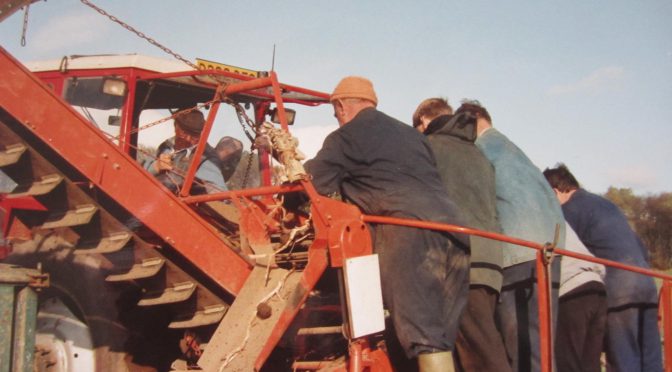Back in the 1950s and 1960s when the great engineering minds were trying to develop a satisfactory potato harvester that would lift the crop without the need of squad labour, you still required a number of workers on the back of the harvester. They lifted all the tatties off the moving belt which were taken away to the tattie box or trailer, leaving the large amounts of rubbish from stones, clods and rots to be conveyed and dropped back onto the ground. The workers worked furiously: it was still hard work. It was even worse when there was a damp bit drill and the whole drill came up the harvester and the tatties had to be removed from the drill sitting on top of the sorting table. You had sore finger ends by the end of the day! And you knew about it!
 Back in these days there were quite a number of attempts to develop a satisfactory harvester. But many of the machines were large and complicated. They were also heavy and cumbersome to work with. The key was to get the design as simple as possible.
Back in these days there were quite a number of attempts to develop a satisfactory harvester. But many of the machines were large and complicated. They were also heavy and cumbersome to work with. The key was to get the design as simple as possible.
In 1966 Johnston’s (Implements) Scotland Ltd, of Colquhoun Street, Stirling, exhibited a potato harvester at the Highland Show, also entering it for the new implement award. It was the Johnson/Underhaug model 1510 potato harvester, invented by Messrs F. A. Underhaug (Fabrik), Stavanger, Norway. It was made by Messrs F. A. Underhaug in association with Messrs Johnson’s (Engineering) Ltd, and sold for £600.
 This one row harvester was described as being “an entirely new concept in potato harvesters”. It used the spinner digger principle for lifting the tatties from the ground. The harvester was fully mounted to the back of the harvester, connected by the three-point hydraulic linkage. A lifting share cut the bottom of the drill and brought the drill and its contents in contact with a spinning reel which spun the potatoes onto a cross-elevator where the surplus soil was riddled out. Trash and haulm were removed at the top of the conveyor and stones deflected onto a cross-conveyor. The remaining contents of the drill was brought onto a sorting table, and the tatties removed from any waste that was brought up with them. They passed onto a trailer or bagging platform mounted onto the front of the trailer.
This one row harvester was described as being “an entirely new concept in potato harvesters”. It used the spinner digger principle for lifting the tatties from the ground. The harvester was fully mounted to the back of the harvester, connected by the three-point hydraulic linkage. A lifting share cut the bottom of the drill and brought the drill and its contents in contact with a spinning reel which spun the potatoes onto a cross-elevator where the surplus soil was riddled out. Trash and haulm were removed at the top of the conveyor and stones deflected onto a cross-conveyor. The remaining contents of the drill was brought onto a sorting table, and the tatties removed from any waste that was brought up with them. They passed onto a trailer or bagging platform mounted onto the front of the trailer.
The harvester was a successful one for the smaller growers: it was extremely compact, lightweight, would work well on steep ground and in wet conditions, was very gentle on the tatties and and could be easily manoeuvred. If you worked steadily with it you could harvest up to 2 acres a day. It was one of the harvesters that was in production for a long period: its production was taken over and marketed by Ransomes as the “Ransomes Faun” and then by the 1990s it was sold by Kverneland as the Superfaun.
Ransomes marketed the Faun as the “handy harvester”, an appropriate name for a really practical harvester. But you still had sore fingers from working with it. They continued to be sore until stone and clod separation came along and revolutionised the tattie harvest. But that is another story.
Source: Highland Show implement catalogue, 1966.
© 2016 Heather Holmes
